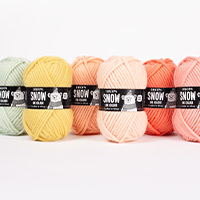Como ler os diagamas de tricô
Um diagrama de tricô é composto por quadrados. 1 quadrado = 1 malha – o símbilo fornece a informação de como se tricota esta malha. O diagrama mostras todas as malhas vistas pelo direito da peça (excepto indicação em contrário).
Um diagrama tem este aspecto:

- A.1 é o nome do diagrama e diz respeito ao diagrama por inteiro.
- A.2 é apenas a parte do diagrama que está dentro dos quadrados separados por linhas mais escuras.
- Este número diz qual o número de malhas que há na 1.ª carreira do diagrama.
- Este é a definição do símbolo: explica como cada malha é tricotada ou em que cor é tricotada (nos pontos com mais de uma cor).
Lê-se um diagrama em sentido contrário ao sentido em que lemos normalmente: da direita para a esquerda e de baixo para cima. Por outras palavras, começa-se no símbolo do canto inferior direito e vai-se tricotando cada malha em direção à esquerda. As carreiras são feitas começando pela de baixo em direção às que estão acima (ver a VERMELHO no diagrama abaixo). Se tem de começar num quadrado diferente/com uma malha diferente, isso é especificado – por exemplo: os diferentes tamanhos de uma peça podem começar em diferentes locais do mesmo diagrama (ver a caixa AZUL abaixo).

If you are supposed to work several repeats of a diagram (ie: work the same diagram several times in width) you’ll work until the end of the diagram row, and start again with the first stitch for the next repeat.
Back and forth:
Se tem de tricotar em idas e voltas, todas as carreiras do direito serão lidas começando no lado direito do diagrama e as carreiras do avesso serão lidas começando no lado esquerdo do diagrama. Uma vez que o diagrama mostra todas as malhas vistas pelo direito da peça, terá de tricotar no sentido contrário quando tricotar o avesso (ver flechas AZUIS no diagrama abaixo): lê a carreira da esquerda para a direita, as malhas meias tricotam-se em liga e as malhas liga tricotam-se em meia, etc (na maior parte das vezes, isso é especificado na definição dos símbolos: “1 malha meia pelo direito, liga pelo avesso”).

Em redondo:
Quando se tricota em redondo todas as carreiras são tricotadas pelo direito e o diagrama é lido na sua totalidade da direita para a esquerda. Sempre que começar uma nova volta, simplesmente comece a tricotar o primeiro símbolo da carreira seguinte do diagrama.

Vários diagramas diferentes tricotados consecutivamente na carreira/volta:
Se estiver a tricotar vários diagramas diferentes, um depois do outro, na mesma carreira/volta, tricotar da seguinte maneira: Tricotar a 1.ª carreira do diagrama 1, continuar com a 1.ª carreira do diagrama 2, depois, com a 1.ª carreira do diagrama 3, etc. NÃO SE ESQUEÇA: se estiver a tricotar em idas e voltas, o diagrama terá de ser tricotado no lado contrário nas carreiras do avesso – ou seja: começar pelo diagrama 3, depois, continuar com o diagrama 2 e, por fim, com o diagrama 1. Também são tricotados em sentido contrário como habitualmente.

Nas explicações de um modelo, pode ler isto: “tricotar A.1, A.2, A.3 num total de 1-1-2-3-4 vezes”. Isto quer dizer que tricota primeiro A.1, depois, A.2 e por fim repete A.3 num total de 1-1-2-3-4 vezes (dependendo do seu tamanho). É APENAS o diagrama A.3 que é repetido. Os diagramas A.1 e A.2 só se tricotam 1 vez.
Quando o número de malhas não corresponde às repetições inteiras do diagrama:
Por vezes, o número de malhas não corresponde à totalidade de repetições em largura do diagrama. Por exemplo: A.1 cobre 12 malhas e é para ser repetido em 40 malhas. Neste casp. Só se tricota 3 repetições completas de A.1 (=36 malhas), e, depois, tricota-se as 4 primeiras malhas do diagrama nas restantes malhas (ver linha VERMELHA abaixo). Geralmente é o que acontece quando o diagram é um ponto repetitivo e, por, isso, independentemente de tricotar repetições completas ou não, o ponto será contínuo.














Ich brauche Hilfe mit dem Diagram, bin erst bei A1 und komme schon nicht weiter "Spill the beans" ist das Muster. Ich durfte hier keinen link einfuegen. Es gibt keine gute Anleitung wie man die Symbole verstehen soll. Vielen Dank fuer die Hilfe.
29.11.2023 - 18:38: